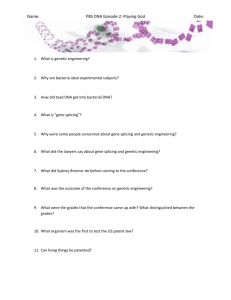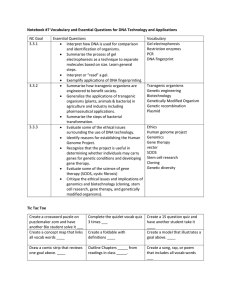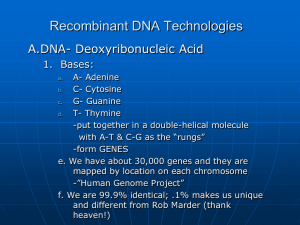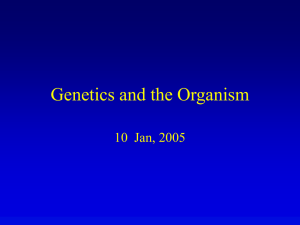Human Genome
advertisement
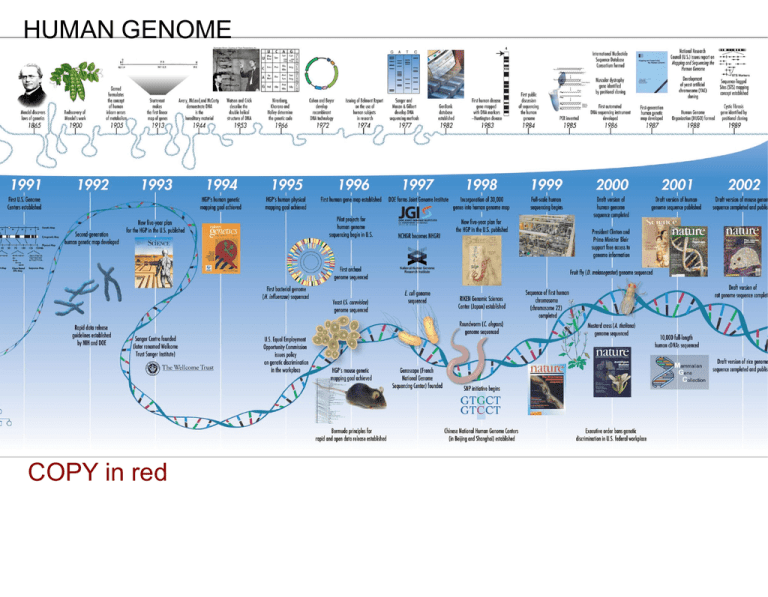
HUMAN GENOME COPY in red Genetic Research Do you recognize each of these organisms? Why are they important to geneticists? These organisms represent a group known as “model organisms.” By working with them, scientists better understand genetics. Guinea pigs E. coli Tobacco mosaic virus Baker’s yeast Wheat Fruit flies Studying the human genome Imagine a small library, with only 46 books. The longest of these books would be 3340 pages, and the shortest 400 pages. The text on the page would be a normal size and there are not any pictures. Now, shrink that library down so it would fit inside the nucleus of a cell. That is the amount of information found in the human genome. Do humans have the largest “library?” Not even close. The marbled lungfish has 130 000 000 000 base pairs in its genome. Humans? Just 3 200 000 000. Dissecting Genomes A genome is the full DNA sequence of an organism. The smallest human chromosome contains 5 million base pairs. In 1990, the Human Genome Project starting mapping the entire human genome with two goals in mind: To determine the nucleotide sequence of all the DNA in human chromosomes To identify the location and sequence of every human gene The project explored gene functions, studied variations among human DNA, and compared human DNA to other species. The Human Genome Project was completed in 2003. Some Completed Genomes Species Genome Size (Nucleotide Base Pairs) Approximate Number of Genes Haemophilus influenzae (bacterium) 1.8 million 1700 Escherichia coli (bacterium) 4.6 million 4400 Saccharomyces cerevisiae (yeast) 12 million 6200 Caenorhabditis elegans (nematode) 96 million 19 000 Arabidopsis thaliana (mustard plant) 125 million 25 500 Drosophila melanogaster (fruit fly) 170 million 13 700 Oryza sativa (rice) 470 million 60 000 Mus musculus (mouse) 2.6 billion 30 000 Rattus norvegius (lab rat) 2.8 billion 25 000 Macaca mulatta (macaque) 2.9 billion 22 000 Pan troglodytes (chimpanzee) 3.1 billion 22 000 Homo sapiens (humans) 3.2 billion 21 000 Model Organisms Comparing genes and sequences can reveal insights about different species. The human Parkinson’s disease gene is similar to a gene for the sense of smell in rats, and a gene for learning songs in a species of finch. These discoveries can lead to therapies and potential cures. Functional genomics studies the genes of model organisms. By understanding specific genes in these organisms, the human genome can also be better understood. Agricultural and plant genomes can reveal potential improvements for food and medicine. The most important aspect of current research is to understand how genes and proteins work together to create organisms. This research has allowed us to identify the locations and functions of human genes and to further Genetic Engineering disorders our understanding of genetic The human population on Earth continues to increase, and somehow everyone needs to eat. How we grow and obtain our food has changed drastically over the past 100 years. Today, large agricultural processes that utilize genetic engineering and biological engineering are managing to keep up with feeding most of the world. It is estimated that more than half of what we eat has been genetically modified in some way. Molecular biologists have only been working with genetics at the molecular level for the past 30 years, yet their results have saved millions of lives, and have changed many industrial processes. How are all of these changes possible using the simple building blocks of life? Genetically modified foods Genetic Engineering - intentionally producing new genes and altering genomes by substituting or introducing new genetic material - in the technique called recombinant DNA, combines genes from different sources, even different species, into a single DNA - the organism most used is a simple bacterium (reproduces every 45 minutes) Genetic Engineering Questions 1. What is one way that recombinant DNA technology can benefit farmers? 2. How can recombinant DNA technology be used to treat diabetes? Biotechnology refers to using living things to help humans produce useful products. This has occurred for thousands of years in our agricultural practices, especially in the breeding of useful organisms. In our modern world, there are a multitude of examples of using biotechnology. Try the activity on right to learn about some uses you may not have known. Once you have finished the activity, please answer the questions found on the tab to the left. Answers 1. What is one way that recombinant DNA technology can benefit farmers? Recombinant DNA technology has been used to develop tomatoes that ripen slowly and corn that is resistant to herbicides. 2. How can recombinant DNA technology be used to treat diabetes? The human gene for producing insulin has been inserted into bacterial DNA. The bacteria reproduce quickly, producing much more insulin than other methods. Insulin is used by diabetics to control the levels of sugar in their blood. Genetic Engineering Genetic recombination Genetic engineering is a branch of biotechnology that involves the manipulation of the actual genetic material of useful organisms. By changing or adding genes, useful traits can be added, and detrimental traits can be removed. Soon, an entire genome could be stitched together from pieces of genetic material. Until that fateful day, we will continue to use technologies such as genetic recombination, where sections from one genetic source are added to another. Watch how genetic recombination works in the animation on the right. Individual genes, or an entire genome, can be cloned. Cloning Cloning can refer to making copies of DNA fragments, cells, or entire organisms. Dolly the sheep (1997) was the first successful mammal clone. Many other mammals have been clones in the years since. Nuclear transplantation is one method used in animal cloning. The nucleus from an adult cell replaces the nucleus in an egg. If the egg begins to develop into an embryo, it is implanted into a host. Gene Therapy Gene therapy is used to treat genetic afflictions. A gene is enhanced or replaced to treat a medical condition. This allows the body to produce the missing protein that causes the condition by using the therapeutic gene. It can be challenging to get the fixed gene to the proper location. Viruses are sometimes used to carry and insert the gene. Cell and tissue transplants, microscopic injections, and aerosol inhalers are also used. Gene therapies are being developed that may help treat Huntington’s disease, skin cancer, cystic fibrosis, and more. Testing is difficult and time consuming; challenges include successfully delivering the new genes and long term success. Gene Therapy Genetically Modified Organisms Scientists have already created many useful organisms in their laboratories. The bacteria C. crescentus naturally creates a biofilm to cover solid objects, and has been modified to absorb heavy metals. This bacterium could be used to clean lake water. While these genetically modified organisms (GMOs) could help, they would also have unknown consequences. A GMO is any organism that has genetically engineered materials. Transgenic organisms have genetic material from other species. GMOs have a wide range of applications in agriculture and medicine. GloFish, gentically engineered fish with fluorescent jellyfish DNA, were one of the first GMOs for sale to the public as pets. Producing Genetically Modified Plants Pest resistant GM crops integrate genes from (bacteria) Bacillus thuringiensis, producing a toxin that kills insect pests. These GM crops do not require spraying with pesticides. Other traits biologically engineered into crop plants include resistance to herbicides and viral infections. GM plants are often used as “factories” to produce desirable materials such as pharmaceuticals, industrial products, and biofuels. Transgenic safflower plants can produce human insulin for diabetics to use, replacing the difficult to refine insulin currently produced by transgenic yeast and bacteria. GM plants can lower production costs and increase yields. Producing Genetically Modified Animals Recombinant DNA is used extensively to produce vaccines and growth hormones for farm animals. These animals themselves can become GMOs as well. Animals are more difficult to bioengineer, as their development is much different from plants. During in vitro fertilization, an egg is fertilized outside of the female, the desired gene is injected into the developing embryo, and it is then implanted into the mother to develop. It can take many attempts before the fertilized egg will accept DNA. Success rates are much lower than with plants. The first successful human in vitro fertilization (IVF) occurred in England in 1977. Early IVF offspring were referred to as “test tube babies.” Producing Genetically Modified Animals “Pharming” refers to using GMOs to producing pharmaceuticals. In pharming, human genes are added to farm mammal genomes. These genes then produce a particular protein, such as hormone, that is generally secreted in the animal’s milk. This method is used when transgenic bacteria or plants cannot produce the required protein or substance adequately. Often, the goal of creating GMOs is the same as traditional breeding programs; to enhance traits already present in the species through selective breeding. Researchers at the University of Guelph developed the GMO “EnviroPig”. Enviropig wastes are much lower in phosphorous than normal pig wastes. Regulating the Use of GMOs There are concerns that the use of GMOs could harm consumers or the environment. What effect will an organism with changed genetic information have when it interacts with normal members of its species? Will GMOs outcompete normal individuals? Will GMOs pass along their genetic changes if they successfully mate with wild organisms? Could engineered genetic traits, such as pesticide resistance, spread to other species through viral transfer? Who owns organisms with certain engineered traits? Although few health problems have been noted, strict regulations are usually recommended for GMOs. Testing of medicines and foods must be done to ensure safety. Regulating the Use of GMOs Governments and agencies around the world are attempting to make GMOs safe and properly understood. In Canada, evaluators from the Canadian Food Inspection Agency (CFIA) and Health Canada assess the safety of new agricultural products made with modern biotechnology. Many countries require any food that has a GMO connection must be labelled as such. pg. 174 #1~3, 5~13, 15~18, 20 Producing Genetically Modified Plants Recombinant DNA technology can be used to improve the characteristics of crop plants. Genetically modified (GM) plants have been made to slow ripening, improve nutrition, tolerate stress, and reduce spoiling. GM plants have replaced traditional breeding practices, especially if the crop’s important traits are found on few genes. GM plants are easy to grow, as an entire new plant can often be grown from a single adult cell. Transgenic plants are often created by using the bacterium Agrobacterium tumefaciens.


